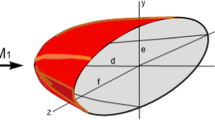Abstract
The flow field characteristics that form for a shock wave propagating through a membrane-like termination at the exit of a shock tube are studied. The strength of the shock wave reflected back into the tube, as well as the strength of the shock wave transmitted, is examined. Six different materials are used, ranging from copper and aluminium foils to a variety of elastic and plastic sheets, in a few cases with different initial pressure differentials. High-speed shearing interferometry imaging is done of the external flow. Three principal characteristics are present in the transmitted flow: a diffracted shock wave, an expansion wave and a re-compression shock wave. It is found that the prominence of these features varies depending on the material type. For the later flow development and material rupture, there are a number of principal characteristics: small vortices, secondary shock waves, a vortex ring, oblique waves and a Mach disc.
Graphic Abstract



























Similar content being viewed by others
References
Biss MM, Settles GS, Staymates ME, Sanderson SR (2008) Differential schlieren-interferometry with a simple adjustable Wollaston-like prism. Appl Opt 47(3):328–335
Brouillette M, Tardif J, Gauthier E (1995) Experimental study of shock-generated vortex rings. In: Brun R, Dumitrescu LZ (eds) Shock Waves @ Marseille IV. Springer, Berlin
https://en.wikipedia.org/wiki/Rupture_disc. Accessed 5 Aug 2018
Kleine H, Le CV, Takehara K, Etoh TG (2010) Time-resolved visualization of shock–vortex systems emitted from an open shock tube. J Vis 13:33–40
Murugan T, Dora CL, De S, Das D (2018) A comparative three-dimensional study of impulsive flow emanating from a shock tube for shock Mach number 1.6. J Vis 21:921–934
Sanderson SR (2005) Simple, adjustable beam splitting element for differential interferometers based on photoelastic birefringence of a prismatic bar. Rev Sci Instrum 76:113703
Schulz J, Skews B (2019a) Flow visualization using a Sanderson prism. J Vis 22:1–13
Schulz J, Skews B (2019b) A shearing interferometer study of shock wave propagation through thin metal sheeting. In: Thirty-second international symposium on shock waves, Singapore, pp 369–381
Schulz J, Skews BW (2019c) Sanderson prism imaging of shock wave impact on thin elastic sheets. In: Proceedings of SPIE, 32nd international congress on high-speed imaging and photonics, p 1105102. https://doi.org/10.1117/12.2517188
Skews BW (1967) The perturbed region behind a diffracting shock wave. J Fluid Mech 29:705–719
Skews BW, Kosing OE, Hattingh RJ (2004) Use of a liquid shock tube as a device for the study of material deformation under impulsive loading conditions. Proc Inst Mech Eng Part C J Mech Eng Sci 218(1):39–52
Zare-Behtash H, Gongora-Orozco N, Kontis K (2009) Global visualization and quantification of compressible vortex loops. J Vis 12:233–240
Author information
Authors and Affiliations
Corresponding author
Additional information
Publisher's Note
Springer Nature remains neutral with regard to jurisdictional claims in published maps and institutional affiliations.
Rights and permissions
About this article
Cite this article
Schulz, J., Skews, B. Shock tube exit flow fields through thin membranes. J Vis 23, 215–229 (2020). https://doi.org/10.1007/s12650-020-00627-0
Received:
Revised:
Accepted:
Published:
Issue Date:
DOI: https://doi.org/10.1007/s12650-020-00627-0




